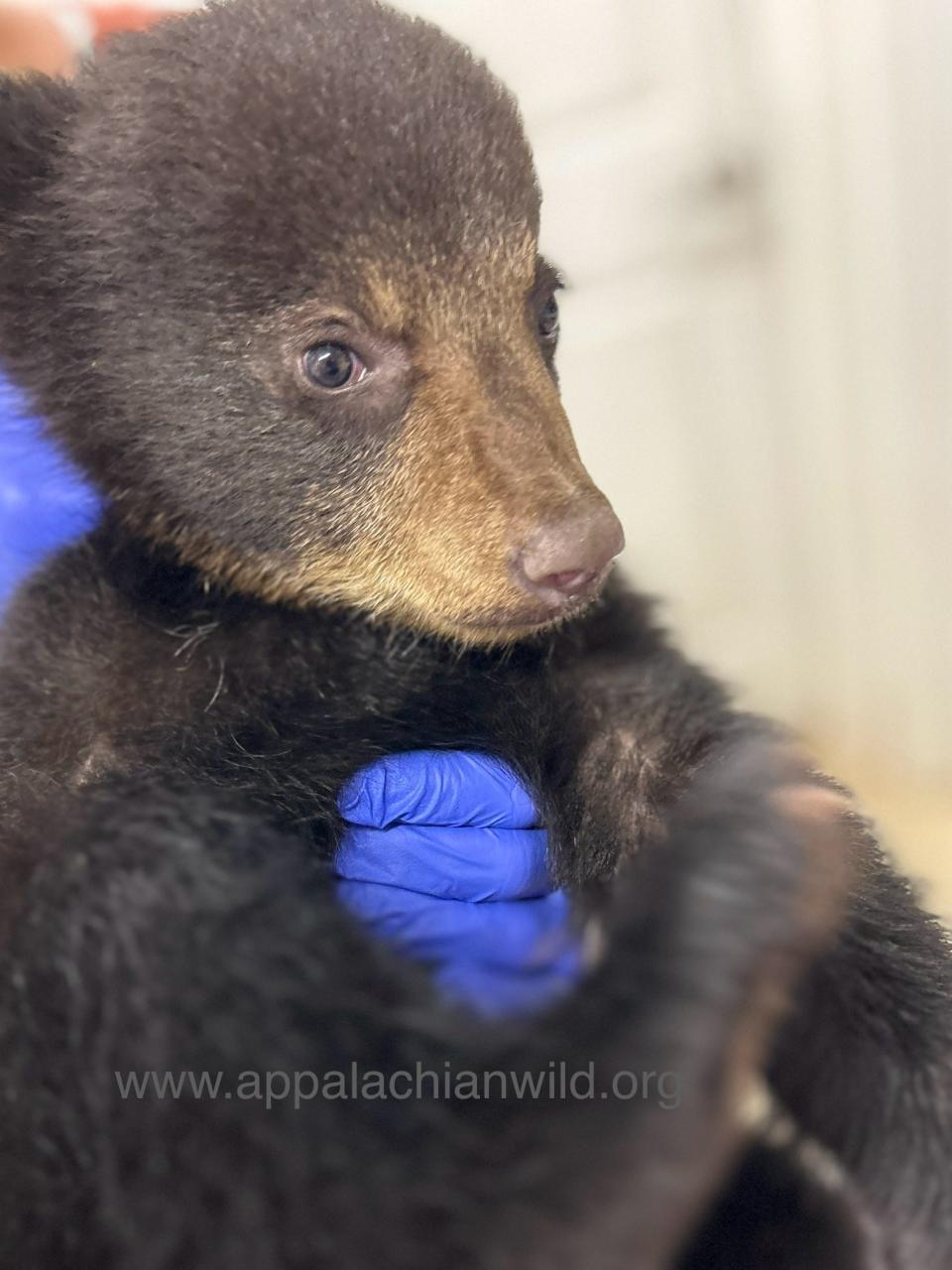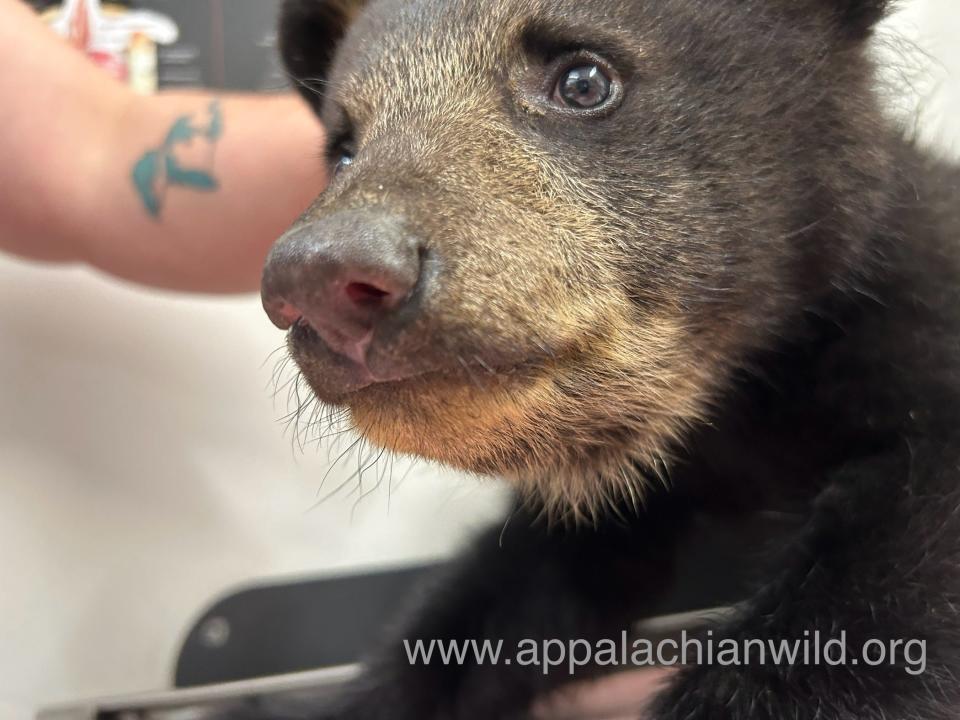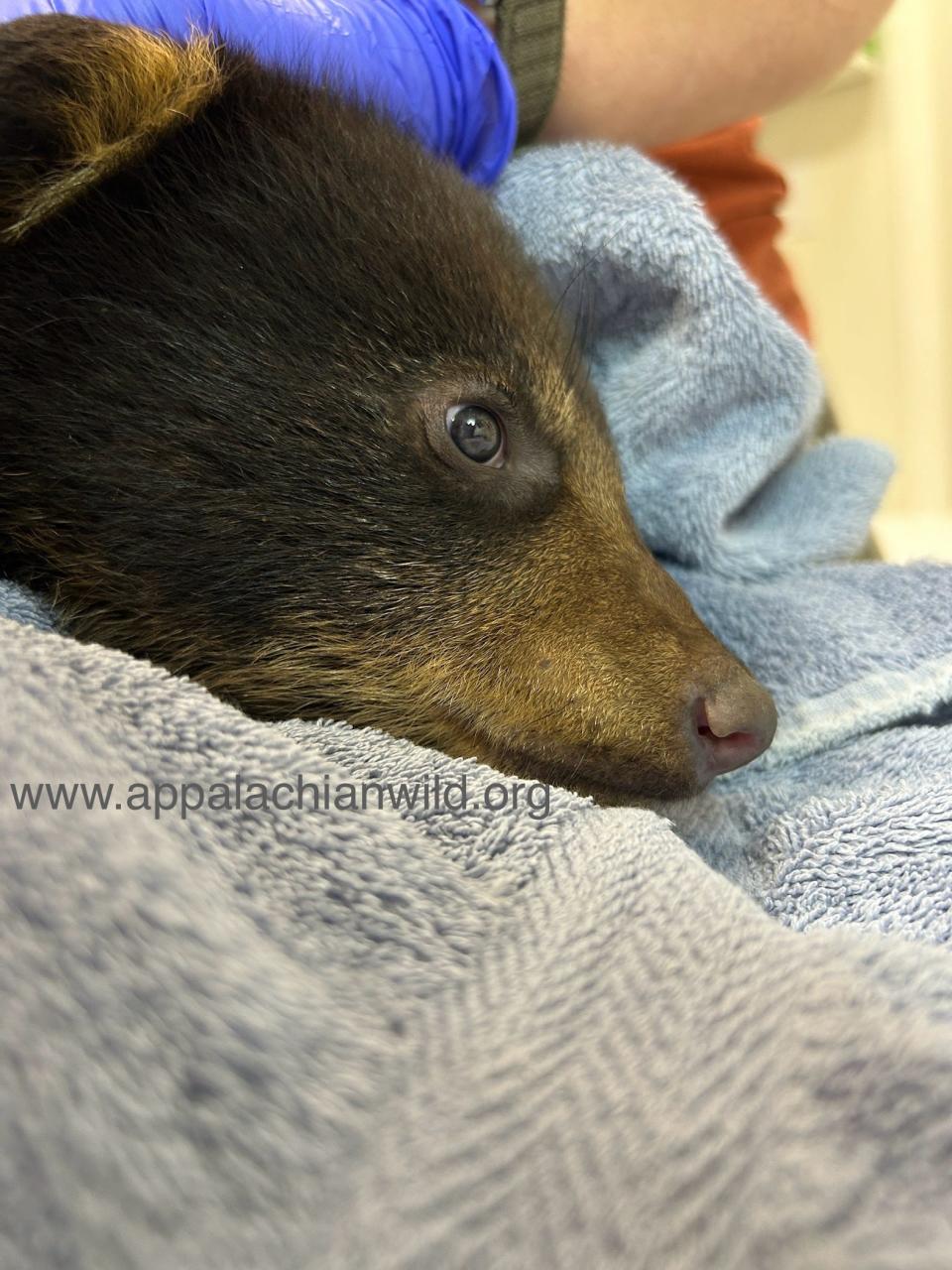Black bear cub pulled from a tree in Asheville 'doing well' in WNC wildlife refuge care
ASHEVILLE - A black bear cub placed in the care of a local wildlife refuge after being pulled from a tree by people posing for selfies at an apartment complex, is "doing well" and expected to be released back to the wild in the fall.
Candler-based Appalachian Wildlife Refuge has spent the past two weeks caring for and stabilizing the cub, which came to the nonprofit April 16, the day of incident, said Executive Director Savannah Trantham.
“This case has understandably brought up feelings of frustration, sadness and anger for many viewers, and we hope the act of witnessing these shocking visuals prompts people to reflect on the very real challenges that wildlife face every day,” Trantham said in an April 30 news release.
While calling the video "disheartening," she said the "silver lining" is that the North Carolina Wildlife Resources Commission rescued the cub.
"It is now safe and being well cared for despite being separated from its mom.”

The incident was captured in a video obtained by the Citizen Times showing a group of people grabbing two black bear cubs from a tree branch extending over a fence to the Berrington Village Apartments property. One woman snatches a cub, and after screaming in excitement, she poses for a picture with the bear.
The cub then drops to the ground and runs along the inside of the fence, attempting to climb the fence a couple of times while the women chases after it.
Ashley Hobbs, a special projects biologist with the NCWRC, previously told the Citizen Times that when she arrived at the apartment complex, one bear cub was wet, cold and alone, sitting in a retention pond. That cub is now at the refuge.
As of April 19, the other cub had not been located. The Commission decided not to press charges against the people videotaped, the Citizen Times reported.
Following time to adjust to being at the refuge, the female cub was introduced to another orphaned cub, Trantham said in the release.
"Both cubs are thriving and doing well in care. They are eating well and interacting with enrichment, doing all the things we hope to see with young cubs," Trantham said. "Our team has no reason to believe that they won’t make full rehabilitation care to be released as wild bears in the fall.”

She told the Citizen Times April 30 that the cub will spend the next several months, "learning to be a bear, and learning how to hone in those natural instincts that she already has of bear behavior."
The refuge is closed to the public to "maintain the wildness of all its patients," the release said. In the case of bear cubs, there is a small staff team designated to work with them. Volunteers and interns never have contact with the bears, keeping them as wild as possible during their rehabilitative stint.
More: 'Shocked' Blue Ridge Parkway traveler recounts seeing visitors 'inches' from black bear
Is this unusual?
Trantham said this case is likely making news because it involves a bear, but the refuge sees the impact of "similar harmful treatment" of other wildlife species on a daily basis.
“If all of the turtles, snakes, rabbits, opossums, squirrels, birds, raccoons, and fawns got the same reaction when people harass, steal, and harm them, then we would be winning,” Trantham said in the release.
“Unfortunately for us, this cub is only one of many animals that we rehabilitate due to the negative impacts of inappropriate human interactions. That is why this work is so important and valuable, so the public understands the harm that is caused by human interference and joins us in working to promote a healthier, more compassionate co-existence with wildlife.”
Since spring 2020 the refuge has rehabilitated 39 injured or orphaned bear cubs with the NCWRC from across North Carolina. The refuge is one of two licensed black bear cub rehabilitation facilities in the state, the release said.
Bear cubs are cared for in natural habitats, isolated from the busy facility until early to mid-fall when they are identified for release and returned to wild areas close to where they originally came from. The refuge has received cubs orphaned by mothers who were killed by cars or gunshots, cubs hit by cars, entangled or trapped in objects, or where cubs are removed from their space and unable to reunite with their mother.

Bear cubs are expensive patients, Trantham said, costing upwards of $2,000-$3,000 in food alone to get a single cub to a healthy release size come fall. A healthy cub will chow down on a combination of specialized formulas, dry foods, fresh produce and whole prey items.
The refuge estimated it spends about $20,000-$30,000 each season on cubs, from food and medical expenses, to habitat maintenance and enrichment.
When the female cub came to the refuge she weighed about 7 pounds, Trantham told the Citizen Times. That's less than the average housecat. As bear cubs in North Carolina are born near the end of January, she's likely 2-3 months old.
Though there were initial reports of potential injury — the cub favoring one of its front paws — the refuge saw no signs of injury, and the cub hasn't shown further signs over the last two weeks.
What to do if you see a cub alone
“It’s not unusual or necessarily concerning for baby animals to be away from their mothers during the spring and summer. Please leave them where you find them and call our hotline or other professionals with questions and guidance for next steps," Trantham said.
"Wild mothers know best," she said, adding that many animals leave their young in safe spaces while they forage and return when it is time to feed or move their charge.
Anyone with questions about wildlife in need can call the refuge’s wildlife hotline at 828-633-6364, ext. 1. For more on living responsibly with bears, visit BearWise.org and the NCWRC’s black bear cub blog to learn more about the agency's orphaned bear cub program.
More: No charge in Asheville bear cub 'harassment' spurs petitions to NC Wildlife Commission
More: Video, witness: Asheville apartment residents pulled black bear cubs from tree for selfie
Sarah Honosky is the city government reporter for the Asheville Citizen Times, part of the USA TODAY Network. News Tips? Email shonosky@citizentimes.com or message on Twitter at @slhonosky. Please support local, daily journalism with a subscription to the Citizen Times.
This article originally appeared on Asheville Citizen Times: WNC wildlife refuge cares for Asheville bear cub from selfie video

